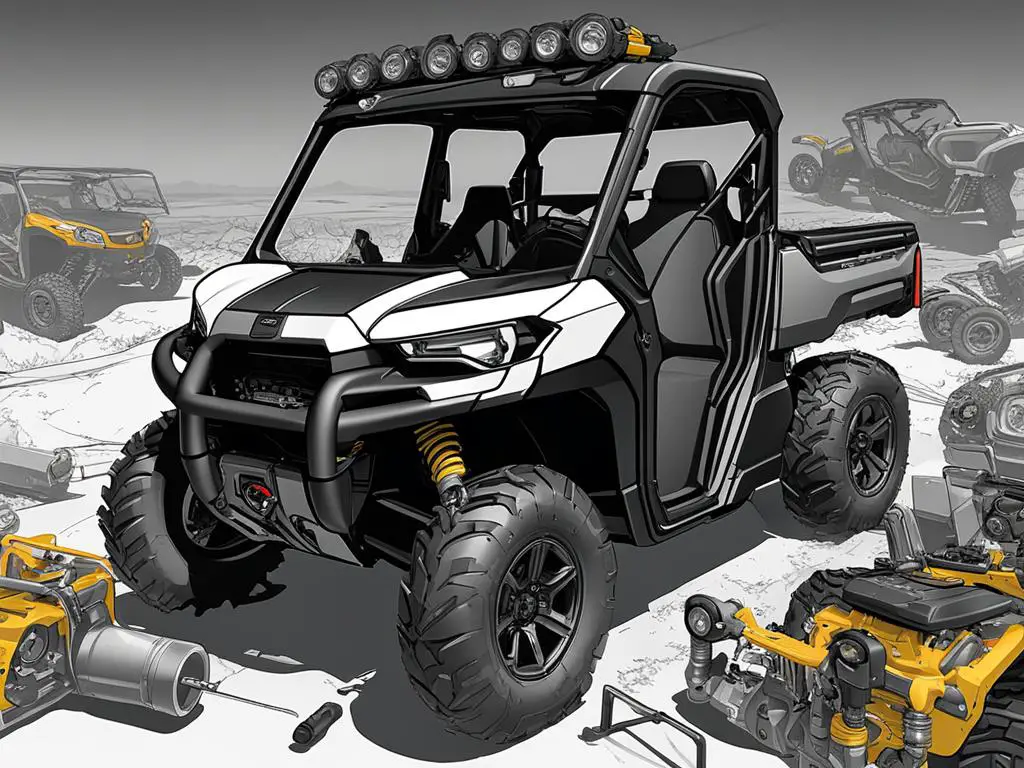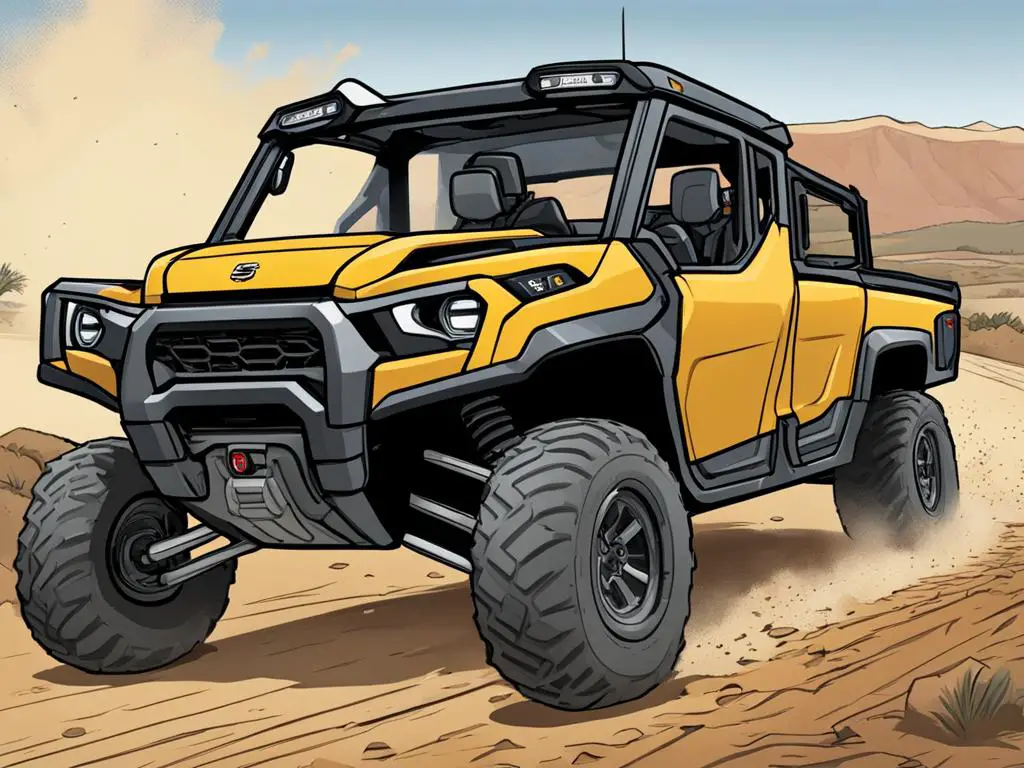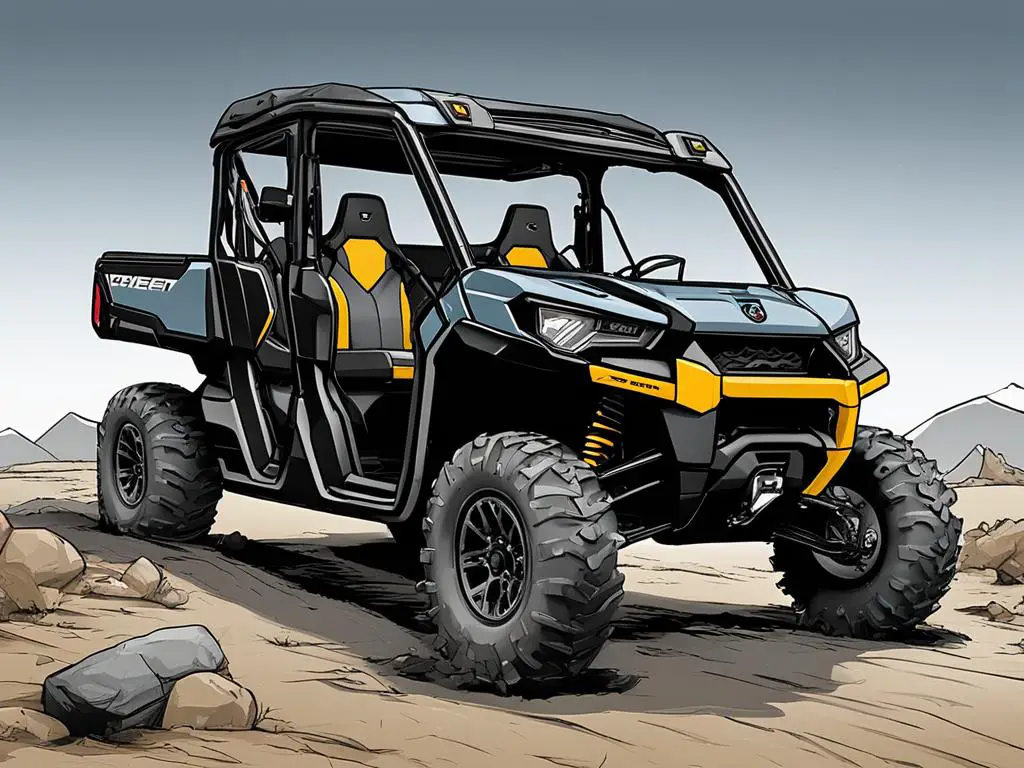The Can Am Defender HD7 is a rugged and dependable off-road utility vehicle that is highly regarded for its performance. However, like any vehicle, it can experience common problems and issues that owners may encounter. It is vital for owners to be aware of these problems and know how to troubleshoot and resolve them effectively.
Some of the common issues with the Can Am Defender HD7 include problems with the reverse chain, A/C malfunctions, and turf mode complications. Additionally, owners may face challenges with the vehicle’s width, battery location, and the use of a belt-driven transmission. These issues can impact the vehicle’s reliability and performance if not addressed promptly.
Fortunately, there are fixes available for these common faults. By understanding these issues and taking the necessary steps to resolve them, owners can maintain the reliability and durability of their Can Am Defender HD7 for years to come.
Key Takeaways:
- Common issues with the Can Am Defender HD7 include problems with the reverse chain, A/C malfunctions, and turf mode complications.
- The width of the vehicle, battery location, and the use of a belt-driven transmission are additional concerns that owners may encounter.
- Knowing how to troubleshoot and resolve these issues promptly is essential for maintaining the vehicle’s reliability and performance.
- Fixes are available for these common faults, ensuring the long-term durability of the Can Am Defender HD7.
- Regular maintenance and inspections can help identify and address any potential issues before they become significant problems.
Related read: Can-Am Defender Leaking Oil: Quick Fixes and Preventive Tips
What is a Can-Am Defender?
The Can-Am Defender is a line of off-road utility vehicles manufactured by Bombardier Recreational Products (BRP). Designed for various purposes, including farm and ranch activities, property management, and outdoor exploration, the Can-Am Defender is a versatile and capable off-road companion. With its robust construction and advanced features, it offers precise handling, exceptional performance, and unmatched reliability. Whether you’re tackling rugged terrains or transporting heavy loads, the Can-Am Defender is built to meet the demands of any task.
The Can-Am Defender lineup includes several models, each with its own unique set of features and specifications to suit different needs. These models include the 4-door Defender MAX, the rugged Defender XMR, and the powerful Defender HD7, HD8, HD9, and HD10. From the spacious interior of the Defender MAX to the enhanced off-road capabilities of the Defender XMR, each model provides a customized experience to cater to your specific requirements.
Key Features of the Can-Am Defender:
- Durable construction and robust chassis for enhanced durability and longevity.
- Powerful engines to deliver exceptional performance and acceleration.
- Ample cargo capacity for efficient transportation of tools, equipment, and supplies.
- Comfortable seating and ergonomic design for a smooth and comfortable ride.
- Advanced suspension systems that provide excellent stability and control over rough terrain.
- Intuitive controls and technology features for effortless operation and convenience.
Whether you’re an outdoor enthusiast seeking adventure or a hardworking individual looking for a reliable work vehicle, the Can-Am Defender is the perfect off-road companion. Its versatility, performance, and advanced features make it a top choice among off-road enthusiasts and professionals alike. Experience the power and capability of the Can-Am Defender and unlock a world of possibilities on every off-road journey.
Common Issues with the Can-Am Defender
While the Can-Am Defender is a reliable vehicle, owners may encounter some common problems during their ownership. Being aware of these issues and taking proper precautions can help prevent them from occurring or minimize their impact.
1. Reverse Chain Breakage
One common problem with the Can-Am Defender is the breakage of the reverse chain, especially when using larger tires or reversing in challenging conditions. The increased stress on the chain can lead to premature wear and eventual breakage. Regular inspection and maintenance of the reverse chain can help prevent this issue and ensure smooth operation.
2. A/C Problems
Another common issue that some Can-Am Defender owners face is A/C problems. Over time, the switches can become gunked up and may not work properly. This can result in ineffective cooling or problems with controlling the A/C settings. Routine cleaning and maintenance of the A/C system can help prevent these issues from occurring.
3. Turf Mode Troubles
Turf mode can also be problematic, particularly when reversing under heavy loads. Some owners have reported instances where the turf mode fails to engage or disengage properly, causing issues during maneuvering. Proper operation and maintenance of the turf mode system, including regular inspections, can help prevent potential problems.
4. Width Concerns
Owners of the Can-Am Defender have also raised concerns regarding the width of the vehicle. It is important to consider the width of the Defender when navigating narrow trails or paths, as it may not fit through certain spaces. Being mindful of width limitations and choosing appropriate routes can help prevent potential accidents or damages.
5. Battery Location
Some owners have found the location of the battery in the Can-Am Defender to be inconvenient. The battery is positioned in an area that may require extra effort to access, especially when maintenance or replacement is required. Understanding the battery’s location and ensuring easy access during inspections or maintenance can help streamline the process.
6. Reliability of Belt-Driven Transmission
The belt-driven transmission in the Can-Am Defender has also been a point of concern for some owners. While it offers smooth operation and versatility, there have been reports of belt failures or other related issues. Regular inspection, proper maintenance, and following manufacturer-recommended guidelines can help ensure the reliability and longevity of the belt-driven transmission.
Being aware of these common issues with the Can-Am Defender and taking proactive measures can help owners maintain the performance, reliability, and enjoyment of their off-road vehicle
Read next: Can-Am Defender AC Problems: Common Issues and Solutions. Regular maintenance checks, following manufacturer guidelines, and addressing any potential problems promptly can help prevent these issues from becoming major concerns.
Can-Am Defender Known Problems
In addition to the common issues mentioned earlier, the Can-Am Defender has a few known problems that have been reported by owners. These problems can vary in severity and may require different fixes or replacements. It is essential for Can-Am Defender owners to be aware of these known problems and take appropriate measures to ensure the reliability and longevity of their vehicles.
Power Steering Problems: Some Can-Am Defender owners have experienced power steering issues, such as difficulty turning the vehicle or a complete loss of power steering functionality. These problems can be caused by a faulty power steering pump, steering rack, or other components.
Steering Rack Issues: The steering rack is an important component of the vehicle’s steering system. Unfortunately, some Can-Am Defender owners have reported issues with their steering racks, including excessive play, stiffness, or complete failure.
Bending Tie Rods: The tie rods in the Can-Am Defender can be prone to bending, especially during off-road use or when subjected to rough terrain. Bent tie rods can affect the vehicle’s steering responsiveness and may need to be replaced.
Belt Problems: The Can-Am Defender utilizes a belt-driven transmission system, and some owners have reported problems with the belts, such as slipping, breaking, or premature wear. A damaged or worn-out belt can impact the vehicle’s performance and may require replacement.
Squeaky Brakes: Can-Am Defender owners have occasionally complained about squeaky brakes. This can be caused by various factors, including worn brake pads, improper brake installation, or issues with the brake calipers. It is important to address squeaky brakes promptly to ensure optimal braking performance.
Stock Battery Drain: Some Can-Am Defender models have experienced stock battery drain issues, where the battery loses charge even when the vehicle is not in use. This can be caused by electrical problems or a faulty battery. It is essential to investigate and address the source of the battery drain to avoid unexpected power failures.
Cab Leaks: A few Can-Am Defender owners have reported issues with water leaks in the cabin area. These leaks can occur through gaps in the doors, window seals, or other areas of the vehicle. Proper weather sealing and regular inspections can help prevent cabin leaks and maintain a comfortable interior environment.
Shifting Trouble: Some Can-Am Defender owners have experienced issues with shifting gears, including difficulty engaging certain gears or gears slipping while in use. This can be caused by problems with the clutch system, gearbox, or other transmission components.
Overheating: Overheating can occur in the Can-Am Defender due to various reasons, such as a malfunctioning cooling system, clogged radiator, or insufficient airflow. It is crucial to address overheating promptly to prevent engine damage and ensure optimal performance.
Regular maintenance, timely repairs, and addressing any problems promptly can significantly contribute to the reliability and longevity of the Can-Am Defender. By staying informed about these known problems and taking appropriate actions, owners can enjoy a seamless off-road experience with their Can-Am Defender.

Can-Am Defender Throttle Response Issues
Throttle response is a crucial aspect of the Can-Am Defender’s performance and acceleration. Two key components responsible for regulating the air-to-fuel ratio and ensuring effective combustion and power delivery are the throttle position sensor (TPS) and throttle body.
A malfunctioning TPS can lead to erratic throttle response in the Can-Am Defender. This can result in unpredictable power delivery, making it challenging to control the vehicle effectively. On the other hand, a malfunctioning throttle body can cause delayed or sluggish throttle response, impacting acceleration and overall performance.
It is important to note that throttle response issues can also be caused by wiring or connector problems, which can disrupt the communication between the TPS and the throttle body. These issues should be addressed promptly to ensure optimal throttle response.
Regular inspection and maintenance of the TPS and throttle body can help identify any potential issues and ensure that they are addressed promptly. This can involve cleaning the throttle body, checking the TPS for proper functionality, and addressing any wiring or connector problems that may be present.
By taking these proactive measures, Can-Am Defender owners can maintain consistent and reliable throttle response, ensuring a smooth and responsive driving experience.

Can-Am Defender Loss of Power and Acceleration
Losing power and experiencing a decline in acceleration can be frustrating issues for Can-Am Defender owners. Several factors can contribute to this problem, including fuel system problems, ignition system issues, air intake restrictions, drivetrain problems, and engine-related issues. Let’s take a closer look at each of these potential culprits:
Fuel System Problems
A malfunctioning fuel system can result in power loss and poor acceleration in the Can-Am Defender. Fuel flow restrictions, such as clogged fuel filters or a failing fuel pump, can limit the amount of fuel being delivered to the engine, affecting its performance. Routine fuel system inspections and regular maintenance can help identify and address any fuel system issues promptly.
Ignition System Issues
The ignition system plays a vital role in powering the engine and ensuring proper combustion. Faulty spark plugs, ignition coils, or ignition timing can lead to inefficient combustion, resulting in reduced power and slower acceleration. Regular inspection and maintenance of the ignition system components can help prevent ignition-related problems in the Can-Am Defender.
Air Intake Restrictions
An obstructed air intake can limit the amount of air reaching the engine, affecting its power output. Dirty air filters, debris in the air intake system, or a malfunctioning mass airflow sensor can all contribute to air intake restrictions. Regularly inspecting and cleaning the air filter and ensuring the air intake system is free from any obstructions can help maintain optimal engine performance and acceleration.
Drivetrain Problems
The drivetrain is responsible for transferring power from the engine to the wheels. Issues such as worn-out drive belts, damaged clutches, or malfunctioning differentials can lead to power loss and reduced acceleration in the Can-Am Defender. Regular inspection and maintenance of the drivetrain components can help identify and address any potential problems.
Engine-Related Issues
In some cases, power loss and poor acceleration can be attributed to engine-related problems, such as a malfunctioning throttle body, faulty sensors, or a restricted exhaust system. Checking for any error codes, performing thorough engine diagnostics, and addressing any identified issues can help restore power and improve acceleration in the Can-Am Defender.
Regular maintenance, prompt repairs, and addressing any potential issues can help maintain the power and acceleration of the Can-Am Defender. By being proactive and attentive to the vehicle’s performance, owners can ensure a smooth and enjoyable off-road experience.
| Common Causes of Power Loss and Acceleration Issues in the Can-Am Defender: | Recommended Actions: |
|---|---|
| Fuel system problems (clogged fuel filters, failing fuel pump) | Regular fuel system inspections and maintenance. Address any identified issues promptly. |
| Ignition system issues (faulty spark plugs, ignition coils, timing) | Inspect and maintain the ignition system components regularly. Replace any faulty parts as necessary. |
| Air intake restrictions (dirty air filters, debris in the air intake system) | Clean or replace the air filter regularly. Ensure the air intake system is free from obstructions. |
| Drivetrain problems (worn-out drive belts, damaged clutches, malfunctioning differentials) | Inspect and maintain the drivetrain components regularly. Replace worn-out or damaged parts as needed. |
| Engine-related issues (malfunctioning throttle body, faulty sensors, restricted exhaust system) | Perform engine diagnostics to identify any issues. Address any identified problems promptly. |
Conclusion
The Can-Am Defender HD7 is a versatile and reliable off-road utility vehicle that is built to handle tough terrain and demanding workloads. While it may encounter some common problems and known issues, proper troubleshooting, timely repairs, and regular maintenance can help ensure its continued reliability and performance.
By addressing any issues promptly and following the recommended maintenance schedules, owners can prevent or minimize problems with their Can-Am Defender HD7. Regular inspections and staying informed about the common problems associated with the vehicle are essential to maintaining its optimal performance.
With the right fixes and attention to detail, owners can enjoy a smooth and enjoyable off-road experience with the Can-Am Defender HD7. Its durability and capabilities make it an excellent choice for those in need of a dependable off-road utility vehicle.
FAQ
What are some common issues with the Can-Am Defender HD7?
Some common issues with the Can-Am Defender HD7 include problems with the reverse chain, A/C issues, turf mode issues, width concerns, battery location, and belt-driven transmission reliability.
What are some known problems with the Can-Am Defender?
Known problems with the Can-Am Defender include power steering problems, steering rack issues, bending tie rods, belt problems, squeaky brakes, stock battery drain, cab leaks, shifting trouble, and overheating.
What can cause throttle response issues in the Can-Am Defender?
Throttle response issues can be caused by a malfunctioning throttle position sensor (TPS), throttle body problems, or wiring and connector issues.
What can cause loss of power and acceleration in the Can-Am Defender?
Loss of power and acceleration in the Can-Am Defender can be caused by fuel system problems, ignition system issues, air intake restrictions, drivetrain problems, and engine-related issues.
How can I prevent or minimize problems with the Can-Am Defender HD7?
Regular maintenance, timely repairs, inspections, addressing any issues promptly, and following recommended maintenance schedules can help prevent or minimize problems with the Can-Am Defender HD7.


Leave a Reply